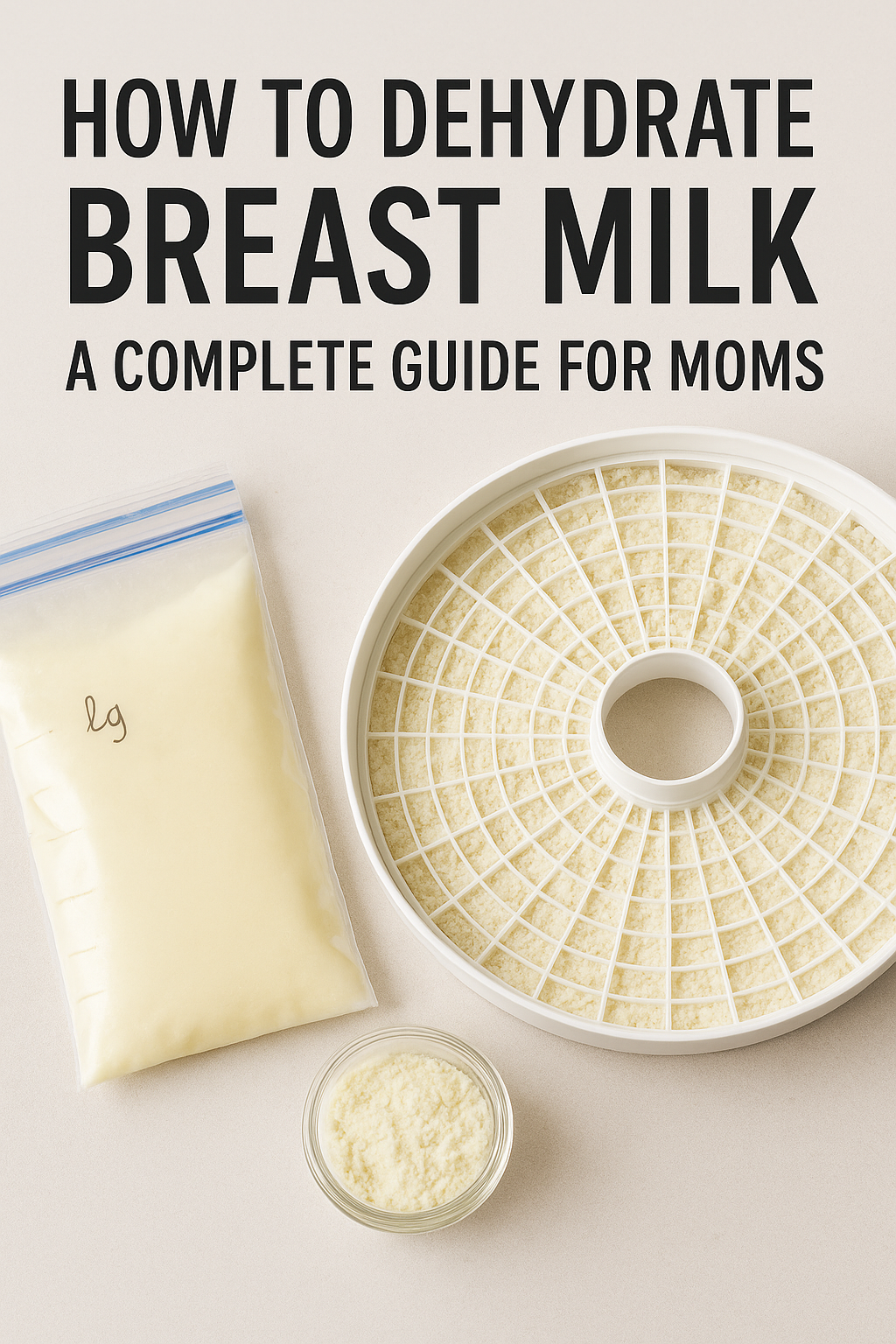
How to Dehydrate Breast Milk: A Complete Guide for Moms
Share
For breastfeeding moms, maintaining a consistent milk supply and preserving milk for future use is often a challenge. One of the most efficient ways to store breast milk long-term is by dehydrating it. Whether you are looking to freeze-dry breast milk or explore safe storage alternatives, understanding the process is essential for maintaining the nutritional integrity of your milk.
This guide will cover dehydrating milk safely, the breast milk powder process, preservation methods, and storage guidelines, along with practical tips for busy moms in Singapore.
Why Dehydrate Breast Milk?
Dehydrating breast milk provides several advantages:
-
Longer Shelf Life: Properly dehydrated milk can last months or even years without losing key nutrients.
-
Convenience: Powdered milk is easier to store and transport than liquid milk, making it ideal for travel or work.
-
Reduced Wastage: Moms can preserve excess milk instead of discarding it, especially during periods of high production.
-
Nutritional Preservation: When done correctly, dehydrated milk retains essential antibodies, proteins, fats, and vitamins.
Dehydration can be a lifesaver for moms looking for flexible feeding solutions while maintaining the benefits of breast milk compared to formula. For nutritional comparisons, see Breast Milk vs Formula.
Understanding the Freeze-Dried Breast Milk Process
Freeze drying breast milk is the most effective method of dehydration because it preserves nutrients and bioactive components. The process generally involves:
-
Freezing Milk: Freshly expressed milk is rapidly frozen to retain cellular structure.
-
Vacuum Drying: The frozen milk is placed under a vacuum to remove moisture through sublimation (ice converts directly into vapour).
-
Powder Formation: The remaining product is fine, dry breast milk powder that can be reconstituted with water when needed.
This method ensures that the milk remains safe for babies while providing a practical long-term storage solution. For ready-to-use products, see Freeze-Dried Breast Milk Powder.
Dehydrating Milk Safely at Home
While commercial freeze-drying is ideal, there are safe ways to dehydrate milk at home if you follow hygiene and temperature guidelines.
Steps for Safe Dehydration:
-
Use Fresh Milk: Always use freshly expressed milk, ideally chilled, for dehydration. Avoid milk that has been stored at room temperature for long periods. For guidance on handling fresh milk, see How Long Can Breast Milk Last Outside.
-
Sterile Equipment: Ensure all containers, trays, and utensils are sanitized. Maintaining pumping hygiene is essential to avoid contamination.
-
Control Temperature: Gradually lower the temperature during dehydration to avoid nutrient degradation. For detailed temperature advice, see Milk Temperature for Baby.
- Monitor Drying: Check the milk regularly for signs of overheating or burning. Proper dehydration leaves milk powder that is dry, free-flowing, and without clumps.
Preservation Methods for Dehydrated Milk
After milk is dehydrated, proper preservation is critical to maintain its nutritional value, antibodies, and safety for baby feeding. Follow these best practices:
- Airtight Storage: Store the milk powder in vacuum-sealed bags or airtight containers to prevent moisture absorption, which can cause clumping and bacterial growth. Ensure the container is completely dry before transferring the powder.
- Cool and Dry Conditions: Keep the powder in a cool, dry place, away from direct sunlight or heat sources. Humid or warm environments can compromise the milk’s quality and encourage spoilage.
- Refrigeration or Freezing: Although not always required, refrigeration or freezing can further extend shelf life and preserve delicate enzymes and antibodies. This is particularly useful for long-term storage or if you have large quantities.
- Portion Control: Divide milk powder into daily or single-use portions. This reduces repeated exposure to air and humidity, which can degrade nutrients and reduce the milk’s immune-protective properties.
- Hygiene Practices: Always use clean, dry utensils when handling the powder. Avoid touching the powder with your hands and ensure storage containers are sanitized.
- Check Expiry and Quality: Even with proper storage, regularly check the milk for unusual odors, discolouration, or clumping. Discard any powder that shows signs of spoilage.
How to Reconstitute Dehydrated Breast Milk
Rehydrating breast milk powder requires careful handling to maintain its nutritional integrity and safety:
- Use Clean Water: Always boil water first, then let it cool to a safe, lukewarm temperature before mixing with milk powder. This prevents contamination and ensures baby safety.
- Add Gradually: Slowly pour water into the powder while stirring gently. This prevents clumping and ensures an even consistency, preserving the milk’s enzymes and antibodies.
- Check Temperature: Always test the milk on your wrist to confirm it is lukewarm before feeding. Milk that is too hot can destroy heat-sensitive nutrients and harm your baby.
- Feed Immediately: Reconstituted milk should be fed promptly. Do not store leftover milk for later use, as bacterial growth can occur rapidly, reducing safety and nutritional quality.
- Stir Well Before Feeding: Sometimes natural separation occurs after mixing; gently swirl the milk to recombine fats and proteins for optimal nutrient delivery.
Benefits of Freeze-Dried Breast Milk
Using freeze-dried breast milk provides multiple advantages for both mothers and babies:
- Nutritional Integrity: Freeze-dried milk retains immune-boosting antibodies, enzymes like lipase, and key nutrients, making it nearly equivalent to fresh milk in nutritional quality.
- Portability: Ideal for travel, day trips, or work, freeze-dried milk is easy to carry without refrigeration, making feeding convenient for busy parents.
- Convenience: Quick and easy to rehydrate, freeze-dried milk ensures that your baby receives safe, nutritious milk even when fresh milk isn’t available.
- Long-Term Storage: Unlike liquid milk, freeze-dried milk can last for months or even years if stored properly in airtight containers, offering peace of mind for parents.
- Reduced Waste: Portion-controlled packets allow parents to use exactly the required amount, preventing waste and maintaining milk quality.
- Emergency Backup: Freeze-dried milk serves as a reliable emergency supply, especially for moms who are traveling or returning to work, ensuring the baby’s feeding schedule isn’t interrupted.
- Supports Working Moms: With freeze-dried milk, moms can maintain their breastfeeding goals without the stress of constant refrigeration or frequent pumping sessions.
- Preserves Immune Benefits: Because antibodies and enzymes are maintained, babies continue to receive protective benefits against infections, even when using reconstituted powder.
For cost considerations and purchasing options, see Freeze-Dried Breast Milk Cost.
Boosting Milk Supply for Dehydration
A steady supply is essential if you plan to dehydrate breast milk regularly:
- Eat Lactation-Friendly Foods: Incorporate foods that support milk production, such as oats, fenugreek, fennel seeds, spinach, almonds, and other nutrient-rich foods. A balanced diet with sufficient protein, healthy fats, and whole grains also supports overall milk quality.
- Stay Hydrated: Milk production requires proper hydration. Drink plenty of water throughout the day, and consider milk-friendly beverages such as lactation teas, smoothies, or warm broths. Avoid excessive caffeine, as it may reduce milk volume or affect your baby.
- Consistent Pumping Schedule: Regular pumping helps stimulate and maintain milk supply. Aim to pump at consistent intervals, ideally every 3–4 hours during the day, and once during the night if possible. This helps ensure that enough milk is available for both immediate feeding and future dehydration.
- Optimize Pumping Techniques: Use a high-quality breast pump and ensure a proper fit of flanges to maximize milk extraction. Relaxation and skin-to-skin contact during pumping can also boost letdown and overall yield.
- Track Milk Output: Keep a log of pumping times and quantities. Monitoring trends can help identify peak production times and adjust schedules for optimal milk collection.
Conclusion
Dehydrating breast milk is a practical and efficient way to preserve your milk for long-term use while maintaining its nutritional value. From freeze-drying breast milk to proper storage and rehydration, moms can ensure their babies receive safe and healthy milk anytime, anywhere. By following strict dehydrating milk safely practices, maintaining hygiene, and understanding storage guidelines, you can confidently incorporate this method into your breastfeeding routine.
Frequently Asked Questions
-
Can I dehydrate breast milk at home safely?
Yes, you can dehydrate breast milk at home, but it requires careful attention to hygiene, temperature, and storage. Ensure all equipment is thoroughly cleaned and sterilized, handle the milk with clean hands, and monitor drying temperatures to preserve nutrients. Following proper methods minimizes the risk of bacterial contamination while maintaining the quality of the milk. -
Does dehydration affect milk nutrients?
When done correctly, dehydration preserves most of the essential nutrients in breast milk, including proteins, fats, vitamins, and antibodies. Freeze-drying, in particular, retains immune-protective properties and enzymes like lipase. Improper handling, overheating, or prolonged exposure to moisture can reduce nutritional value, so it’s important to follow safe dehydration practices. -
How long can freeze-dried breast milk last?
Freeze-dried breast milk can last several months to years if stored in airtight containers in a cool, dry, and dark place. Moisture, heat, and light are the main factors that can degrade the milk, so proper sealing and storage conditions are essential for extending its shelf life while keeping it safe for baby consumption. -
Can I combine milk from different pumping sessions for dehydration?
Yes, combining milk from different pumping sessions is possible, but only if all milk is fresh, chilled, and handled with care. Mix gently to preserve fat globules and proteins, and ensure that milk from earlier sessions is used first if storing for long-term dehydration. This practice helps reduce wastage and makes portioning for dehydration easier. -
Is freeze-dried milk safe for babies?
Freeze-dried milk is safe for babies when prepared and stored correctly. It maintains most of the immune-protective properties and nutrients of fresh milk. However, it must be rehydrated properly with safe, clean water and fed at the right temperature to ensure it is both safe and palatable for your baby. -
How do I rehydrate powdered milk?
To rehydrate powdered milk, use boiled water that has been cooled to a safe feeding temperature. Add the water gradually to the powder, mixing gently to avoid clumps. Once fully rehydrated, check the milk temperature to ensure it is lukewarm and safe for your baby to drink. Any leftover milk should be discarded after a single feeding to prevent bacterial growth. -
Can I travel with dehydrated milk?
Yes, powdered or freeze-dried milk is highly convenient for travel. It is lightweight, easy to store, and does not require refrigeration until rehydrated. Always keep it in sealed, moisture-free containers and carry only the portions you will need for the trip. Rehydrate milk just before feeding to maintain freshness and safety. -
How much milk should I dehydrate at a time?
It’s best to divide milk into small portions for dehydration. This makes it easier to manage, prevents waste if only some is needed, and ensures even drying. Portioning also allows for faster rehydration and reduces the risk of contaminating large amounts of milk. -
Are there commercial freeze-dried options?
Yes, commercially prepared freeze-dried milk is available and convenient for moms who want a ready-to-use solution. These products are processed under controlled conditions to preserve nutrients and can be stored long-term. They are especially helpful for travel, emergencies, or when the pumping supply is inconsistent. - How do I prevent contamination during the dehydration process?
Preventing contamination requires strict hygiene. Wash hands thoroughly before handling milk, clean and sterilize all equipment, and use airtight containers for storage. Avoid exposure to heat, moisture, or unclean surfaces, and always handle milk in a clean environment to ensure that the dehydrated product is safe for baby consumption.
